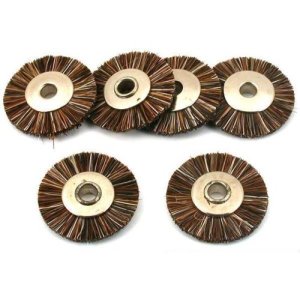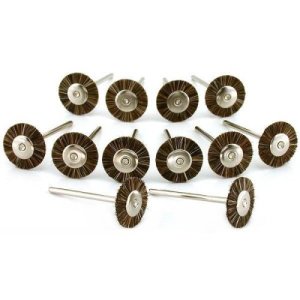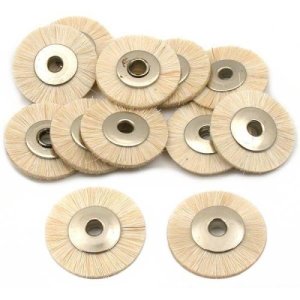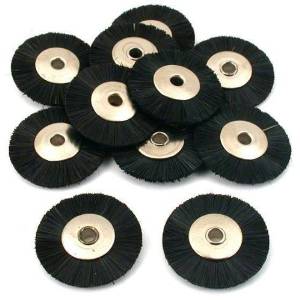Polishing is something that everyone that works on jewelry will have to do, and there are a few tools that will make your job a lot easier. Today we will look specifically at polishing brushes, soft, medium, and stiff brushes and when to use them.
First let’s look at applications for the brushes. You can get the either Mounted on a mandrel or Unmounted
. I prefer the unmounted ones, because I use them on a Screw Mandrel
or on a Polishing Machine Mandrel
. They both work about the same, you can try them both, but I like the unmounted ones better, they are easier to store, (less bulky) and quicker to load and unload on a mandrel.
Let’s look at how each one works:
Soft Brushes: Work good for rounded surfaces, areas with grooves, and areas where “crispness” is not an issue. I like to use these brushes with an aggressive compound on “organic” shapes to take out scratches and blend curves. If you think about how this brush works, you are actually using the side of the bristle to polish because when you apply it to the metal, it is soft and the bristles fold over easily. You can also use a Red Rouge Compound
on these brushes and softly go over areas to bring back a bright shine.
Stiff Brushes: Work good for getting inside tight areas, like inside of gallery work and in between prongs on settings. These brushes work good at getting into sharp corners and inside edges. Use a medium compound on this wheel like a White Diamond Tripoli Compound
or Graystar Compound
. If you think about how these brushes work, the bristles are stiff and the ends of the bristles work better because they do not fold over as easy.
Medium Brushes: Work good for all around areas. I like these for most applications. This brush reacts to pressure much better, if you need the soft blending action of a soft brush, use an aggressive compound and add more pressure. Add less pressure and it will get into tight areas like in between prongs and corners. Keep a couple of these around with different compounds on them, Gray and Red for pre-polishing and finishing. Do not mix compounds.
I am sorry I didn’t get any good “at the bench” photos, but I hope you can understand. I will talk more on polishing at a later date.
Now go make something shiny!!!
Doug




Hi, Thank you thank you!!!!! i’m so happy getting your e-mails, they are so helpful !!! Would it be possible for you to talk about polishing compounds, their specifics and with lots of pictures please. Thanks!!!
Thanks Diane, I will do that.
Doug
I would love that as well. You are not saying that red rouge is aggressive? I have always used it as a final stage compound. Is this correct? Thank you! i am so enjoying your posts!
You are correct, Red rouge is for the final polishing step. The gray and Brown are the more aggressive “tripoli” compounds for going after deeper scratches.
Comments are closed.